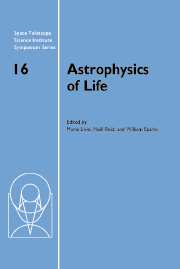 Astrophysics of Life
Astrophysics of Life Published online by Cambridge University Press: 29 August 2009
Stellar nucleosynthesis of heavy elements, followed by their subsequent release into the interstellar medium, enables the formation of stable carbon compounds in both gas and solid phases. Spectroscopic astronomical observations provide evidence that the same chemical pathways are widespread both in the Milky Way and in external galaxies. The physical and chemical conditions—including density, temperature, ultraviolet radiation and energetic particle flux—determine reaction pathways and the complexity of organic molecules in different space environments. Most of the organic carbon in space is in the form of poorly-defined macromolecular networks. Furthermore, it is also unknown how interstellar material evolves during the collapse of molecular clouds to form stars and planets. Meteorites provide important constraints for the formation of our Solar System and the origin of life. Organic carbon, though only a trace element in these extraterrestrial rock fragments, can be investigated in great detail with sensitive laboratory methods. Such studies have revealed that many molecules which are essential in terrestrial biochemistry are present in meteorites. To understand if those compounds necessarily had any implications for the origin of life on Earth is the objective of several current and future space missions. However, to address questions such as how simple organic molecules assembled into complex structures like membranes and cells, requires interdisciplinary collaborations involving various scientific disciplines.
Introduction
Life in the Universe is the consequence of the increasing complexity of chemical pathways which led to stable carbon compounds assembling into cells and higher organisms.
To save this book to your Kindle, first ensure [email protected] is added to your Approved Personal Document E-mail List under your Personal Document Settings on the Manage Your Content and Devices page of your Amazon account. Then enter the ‘name’ part of your Kindle email address below. Find out more about saving to your Kindle.
Note you can select to save to either the @free.kindle.com or @kindle.com variations. ‘@free.kindle.com’ emails are free but can only be saved to your device when it is connected to wi-fi. ‘@kindle.com’ emails can be delivered even when you are not connected to wi-fi, but note that service fees apply.
Find out more about the Kindle Personal Document Service.
To save content items to your account, please confirm that you agree to abide by our usage policies. If this is the first time you use this feature, you will be asked to authorise Cambridge Core to connect with your account. Find out more about saving content to Dropbox.
To save content items to your account, please confirm that you agree to abide by our usage policies. If this is the first time you use this feature, you will be asked to authorise Cambridge Core to connect with your account. Find out more about saving content to Google Drive.